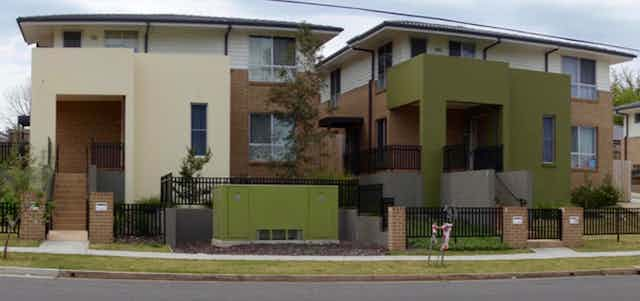Housing affordability is a hot topic in Australia. Governments are increasingly recognising that more needs to be done to provide a greater range of affordable housing options, especially in the major cities. It is well documented, however, that proposals for affordable housing development often encounter opposition from host community members.
These community concerns tend to focus on the potentially damaging effects of such projects on property values and quality of life for existing residents. This is despite the public being generally supportive of affordable housing in principle. They would just prefer it wasn’t sited in their local area.
In reality, though, do the concerns that people have about affordable housing development materialise? Do property values go down? Does neighbours’ quality of life suffer?
Our case studies in Brisbane and Sydney provide evidence that, in most cases, they do not.
Testing for local property impacts
How did we test for the impacts of affordable housing projects? With thanks to Australian Property Monitors, we had access to property sales data throughout the Brisbane local government area (LGA), going back to 1999.
Using this data, we tested the impacts of 17 affordable housing developments on property sale prices through two different hedonic pricing models. The models were designed to test whether:
The announcement and eventual construction of affordable housing projects had any impacts (positive or negative) on local property sale prices. Project announcement date was used to capture any “panic sales” that may have happened as a response to the announcements.
The extent of such impacts depended on proximity to the development (by direct distance in 100-metre intervals, up to 500 metres away from the affordable housing project).
The two models were used to test these outcomes collectively for 17 affordable housing projects that were developed across Brisbane LGA between 2000 and 2009, and also on an individual project basis.
Collectively across the 17 projects, these had no significant negative impacts on local property prices. There were mild impacts on properties within 100 metres of affordable housing projects, but not at any statistically significant level.
We found that the characteristics of the individual properties sold (such as number of bedrooms, number of bathrooms) consistently had much greater influence on sale prices than proximity to affordable housing developments.
When looked at individually, the impacts of each project on local property prices were mixed. Some affordable housing projects had positive impacts and others negative.
Only a handful of the measured impacts were statistically significant, however. Even in these cases the impacts of proximity to affordable housing had much to do with other features of the neighbourhood (such as proximity to public transport hubs, water frontages and so on).
These two tests clearly showed that the impacts of affordable housing development on local property sales prices had been minimal. The impacts that were experienced were not universally negative (or positive).
Impacts on the quality of life of neighbours
What then of the impacts on neighbours’ overall quality of life? How does an affordable housing development affect things like traffic, crime, an area’s visual appearance, or sense of community?
To understand this, we conducted doorstep surveys with 141 residents who lived close to (within about 60 metres) eight affordable housing projects in Parramatta local government area.
These projects had been locally opposed but still completed. We selected the most-controversial projects and were able to achieve participation by between one-fifth and one-third of the 60 or so residents likely to have been most affected by those developments.
We wanted to know whether people’s fears at the planning stage had materialised once the developments were complete and occupied.
Across the eight projects, 78% of respondents had experienced no negative impacts as a result of affordable housing development. At only two of our eight sites had a significant number of neighbours experienced negative impacts. These impacts were mostly associated with the behaviours of a small number of individual residents.
At the other sites, the negative impacts were dispersed. Mostly, these related to minor issues such as parking and traffic.
Fears are an obstacle in themselves
Overall, our findings indicate that the feared impacts of planned affordable housing developments tend to be much greater than the impacts neighbouring residents actually experience once those developments are complete and occupied.
In other words, the perception of affordable housing is the key problem, not the affordable housing developments themselves. These are by and large unproblematic once completed.
These findings suggest that governments and developers need to devote much more attention to tackling negative public perceptions of affordable housing and its residents.

